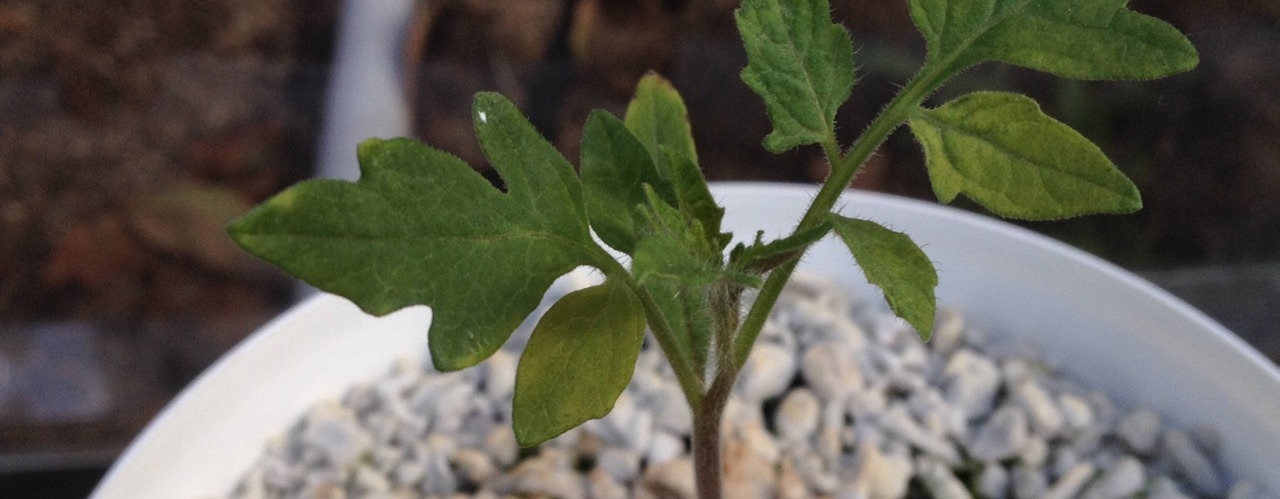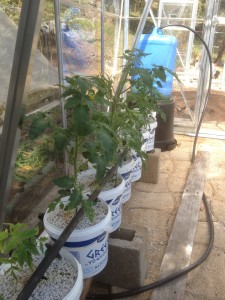
Our aquaponics system has been running-in and settling-down for a month now. As expected, it has needed some adjustment, but it is working well for a first time try. Now that the system has proved itself it’s time to expand and get some of those rain-sensitive Summer crops going.
Tweaking the system has involved more structures, like a shade house for the pond, a sand filter, and setting up for expansion, but the main issue has been controlling the pH of the reservoir.
The aquaponics system at one month
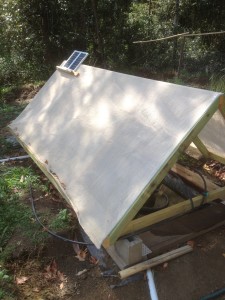
As a first time trial, I wasn’t at all sure how well the aquaponics system would work, so I started with the basic infrastructure (pond, pump, piping) and a row of nine, two litre pots of tomatoes in a greenhouse to see how they fared.
The system is powered by a solar pond pump which sends water to the hydroponics system, but also recirculates the excess pumped water back to the pond.
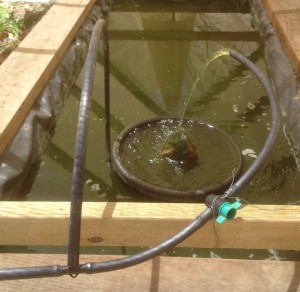
The pond pump has worked much better than I expected. I put a T junction on the out-take so that the pumped water can be directed either to the hydroponic head tank or back into the pond as an aerating and filtering stream. The picture on the left shows the pump outlet. The line splits to a hydroponic feed and a recirculation feed. The recirculation water runs through a sand filter, which is simply a pot of sand set a little higher than the pond surface.
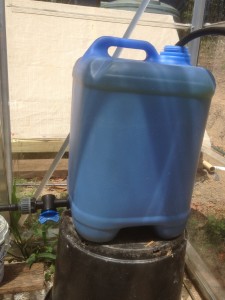
It turned out by luck that the hydroponic head tank is just the right height to almost fill when the pump is working in good sunlight, but at near full the pressure head is enough that pumped water is diverted through the recirculation feed, so the hydroponic tank is self-regulating. That is, it automatically fills when the pump is running, but doesn’t over-fill.
The system pumps a lot of water and looks to have the capacity to fill both greenhouses. In theory I can expand as long as each pot gets a trickle of water when it’s sunny, and there is space to house them. I think space might run out first.
Practicalities and adjustments
The pond cover. As the pond was originally in full sun, algae very quickly turned the water green. This in itself is not a problem in a closed system as it feeds the fish, but too much can block the flow elements. I put up a quick shade cloth cover on a bamboo frame, but Bill made a permanent and sturdy structure which holds the cloth tightly and also makes a stand for the solar panels. Less sunlight means less algal growth.
The sand filter. Sand filters help reduce particulates in the pond water and also provide a habitat for the bacteria which help maintain the system balance. I made a simple filter by half-filling a large plastic pot with river sand (first covering the drainage holes with shade cloth). The recirculation water falls into the pot (a rock set on the sand minimises churning) and because the pot is set a little higher than the pond water level, there is a slow recirculation of water through the sand, while excess spills over the pot rim.
pH. This has been the biggest deal with setting up the system, and is critically important for success. pH tends to rise with time (the water becomes alkaline) which I noticed from setup. Most plants, especially tomatoes, need pH slightly on the acid side of neutral (pH 6 to 7), and the pH of 8 or so I was measuring was clearly no good for the tomato seedlings in the hydroponics, as they had leaves with dark veins and pale edges.
To bring back acidity I bought some hydrochloric acid but was a bit heavy handed and brought the pH way down to 4 or so, so threw some lime in the pond. That again was too heavy handed, and the pH rose again to near 8 after a few days. Since then I have monitored frequently and just added a capful or so of hydrochloric acid each time the pH rises above 7. That’s about 20 mL of acid for an 800 L tank.
pH is a complicated thing, but the main points here are;
- the aquaponics tank water has to be monitored as neither plants nor fish will survive if the pH swings too far.
- pH tends to rise in this sort of system, and that needs to be countered with an acid.
- Hydrochloric acid is most effective but very dangerous and strong. Safety equipment must be used (gloves, glasses) and any accidental contact with skin or body must be immediately washed off with copious water. Read the safety notice on the bottle before you start if you are thinking of trying this. The golden rule with concentrated acid is to add it to the water, i.e., pour it carefully onto the water surface without splashing.
- I have seen suggestions of using vinegar as a safe substitute. It may work short-term, but I expect it would be rapidly consumed by the organisms in the system.
- Other mineral acids like phosphoric acid would also work, but hydrochloric is readily available from hardware stores for pools, concrete cleanup, etc.
- Acid brings the pH down (pH 5 is too acid for most plants and pH 7 is neutral).
- Conversely, the best agent for raising pH is lime.
- Just water with nutrients has little buffering capacity, so small additions of acid or lime can have large effects on pH. I now add a very small amount, allow the water to recirculate for a day, then re-test the pH.
- A pH meter is a good investment for an aquaponics or hydroponics system, but they are expensive and can be misleading if not properly used and calibrated. I use a standard soil pH kit (essentially a bottle of universal indicator). A drop of indicator in a water sample gives an immediate and accurate reading.
Since I got the pH under control the tomato plants have surged ahead. Dark veins in pale leaves is a sure sign that there’s trouble in the water, but the plants also respond very quickly to adjustments.

Expansion. This will be easier than I imagined, as one hydroponic header tank will be able to feed a whole greenhouse of pots, and the return drainage of 4 cm poly pipe was very easy to set up. I have my next lot of peat pots sown with another lot of heirloom tomatoes, and will start some capsicums too next. I’m also wondering how zucchini might fare; they need to be kept out of our Summer rain, but they are very big plants. I suppose I’ll just have to give them a try.

